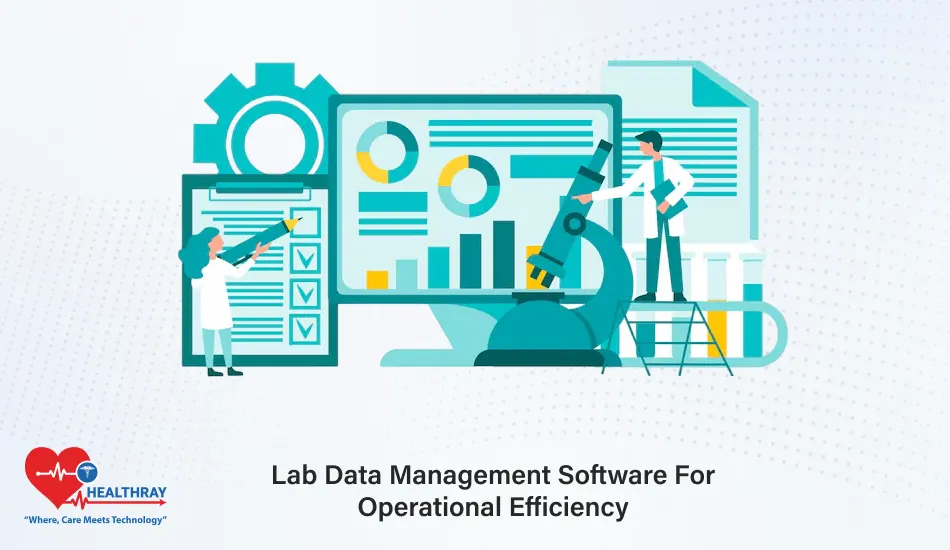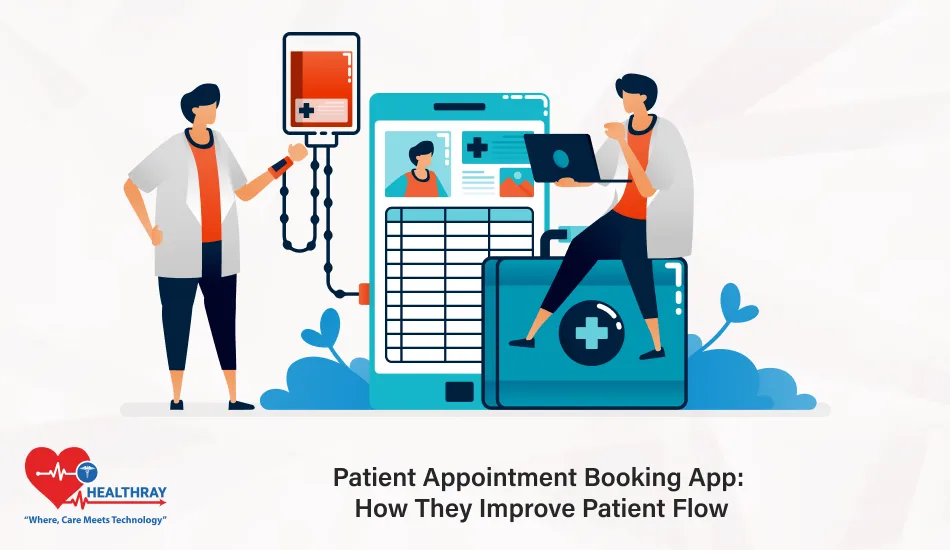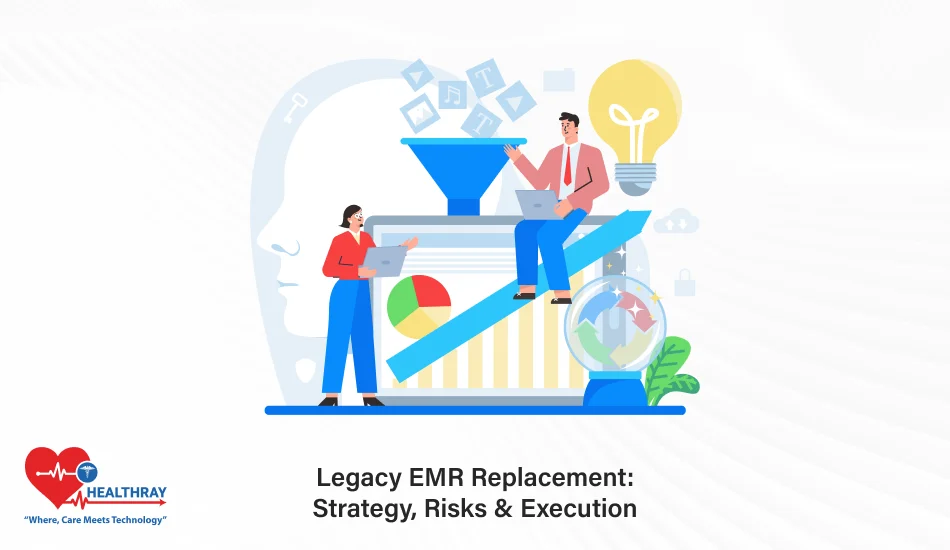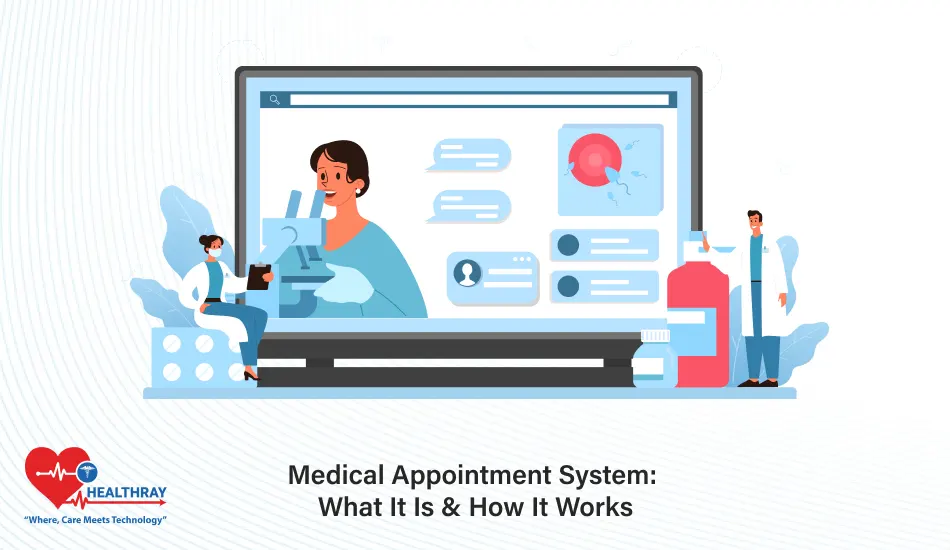Multitasking is a challenge every lab manager and biotechnology decision-maker has to endure: from regulatory compliance to growing volumes of data management, it’s a delicate balancing act. The Laboratory Information Management System eases these burdens through streamlining workflows, automating processes, and improving data access.
There is more to it than just efficiency. It renews how labs work: reducing errors, optimizing resources, and increasing speeds of decision-making. Be it clinical trials, research data management, or routine tests, the right software can make your lab wiser and more productive.
Key Challenges in Lab Operations and How our Software Can Solve Them
The laboratories must deal with a combination of unique issues that contribute to slowing them down, hence general productivity. Here is a look at some of the most pressing issues and how lab data management software can help:
Data Overload
With modern labs generating massive volumes of data from a set of instruments, tests, and experiments, manual management is at best tiresome and at worst prone to errors.
How Software Helps:
Lab management software centralizes all your data in one place so you can access it at any time. Real-time tracking with data integration tools allows your team to spend more time analyzing the information rather than searching for it.
Maintaining Regulatory Compliance
Mastering such compliance with industry standards, such as ISO 17025, FDA, or GLP, is so overwhelming at times. Sometimes mistakes in documentation and delays in deadlines have greater repercussions.
How Software Helps:
Advanced solutions come with built-in compliance management. It automates audit trails, version control, and SOP templates for ease in the process. You’ll maintain compliance with regulations and eliminate the risk of human error.
Inefficient Workflows
Manual workflows, starting from sample tracking to reporting, are cumbersome and easily reach bottlenecks.
How Software Helps:
Automation eliminates repetitive jobs, including the entry of data and labeling of samples. Most systems have workflow customization, allowing labs to plan processes that can best suit their needs. This ensures faster turnaround times with a high degree of consistency. Major Challenges in Lab Workflow & How Our Software Can Help
Data Accessibility and Collaboration
Laboratory teams can often be quite siloed in their operations, which greatly impacts communication and efficiencies. Sharing data among departments or external stakeholders sometimes can be very slow and complicated.
How Software Helps:
Cloud-based laboratory management systems allow effective collaboration. That is because, at any instance in time, several users can have access to the data to view or update it, keeping the environment secure, which obviously guarantees quicker decision-making and collaboration.
Cost Overruns
Poor use of resources, instrument downtimes, or human errors can inflate operational costs.
How Software Helps:
Laboratory software that features resource tracking and predictive analytics identifies underutilized assets, automates the scheduling of preventative maintenance, and thereby minimizes downtime while maximizing ROI on expensive equipment.
Addressing these challenges means lab data management software is not only a tool but also a strategic asset for any laboratory seeking to enhance operational efficiency and scale its capabilities.
Top Features to Look for in Lab Data Management Software
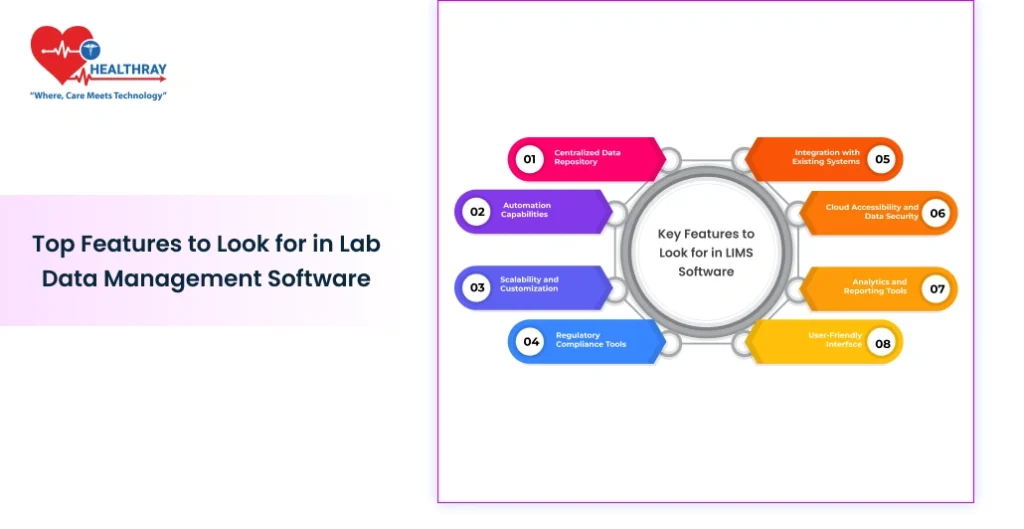
Selection can be overwhelming with the huge array of choices available in lab data management software. Trimming down your options to those features that add the most value to your operation is very important. Here are the top features that every lab manager or decision-maker should focus on:
Centralized Data Repository
The laboratories deal in test results, research data, instrument logs, and much more. A centralized system puts all information at the fingertips of a researcher in an organized and secure fashion.
Why It Matters:
One source of truth reduces data silos and increases the ability of your team to locate what they need faster. It improves collaboration and decision-making.
Automation Capabilities
Manual tasks, like data entry, tracking of samples, or reporting, are very time-consuming and prone to a lot of human errors. Automation smooths out such tasks and frees the lab personnel for higher-value-added work.
Key Automation Features to Look For:
1. Sample tracking by barcode or QR code.
2. Automate your workflows for repetitive tasks.
3. Integrating reporting tools with minimum user input.
Scalability and Customization
Every laboratory has its own set of demands that evolve with time. The software should be flexible enough to adapt to your particular workflows and grow with you.
Key Considerations:
1. Does the software offer field, form, and workflow customization?
2.Can it handle increased data volumes or integrate additional instruments as your lab grows?
Regulatory Compliance Tools
For biotech and pharmaceutical labs, there is no option but to comply with regulatory requirements. In this regard, look for software that supports FDA 21 CFR Part 11, ISO 17025, and Good Laboratory Practices.
Essential Compliance Features:
1. Automated audit trails
2. Electronic Signatures and Version Control
3. Predefined Templates for SOPs and Regulatory Reporting
Integration with Existing Systems
Laboratory Information Systems tend to implement several systems for instruments, ERP, or customer relationship management. The software should interface easily with them to form a unified workflow.
Cloud Accessibility and Data Security
Cloud-based solutions are gaining momentum, and a great deal of work is now being done remotely. Therefore, they facilitate access to lab data from anywhere securely.
Why It’s Important:
It also provides more scalability for a system, reducing heavy IT infrastructure. Ensure that your provider has the required security measures in place, including encryption and multi-factor authentication.
Analytics and Reporting Tools
Data is only useful if you can interpret it. Look for software with intuitive dashboards, predictive analytics, and customizable reports.
Example Use Cases:
1. Monitoring instrument performance trends
2. Bottleneck identification in workflows
3. Resource requirement estimation considering past data
User-Friendly Interface
No matter how advanced the software, if your team finds it hard to use, it’s essentially useless. A clean, intuitive interface minimizes the learning curve and increases adoption.
Advantages of Lab Data Management Software Implementation

The adoption of Lab Data Management Software is more strategic than an upgrade, as it actually changes how a laboratory works. Which brings us to some significant benefits that make this investment worthwhile.
Smarter workflows
In addition, laboratory workflows contain a lot of repetitive activities, such as tracking samples, data logging, and compliance reporting. These can inhibit productivity when handled manually.
How This Helps:
Automation reduces delays and errors to allow for quicker turnarounds. In this regard, laboratory personnel will be freed to focus their attention on more value-added activities, such as the analysis of data or research.
Smarter Data Accuracy
Human error in data entry or management can lead to very costly mistakes, especially in critical environments such as those of a pharma or biotech lab.
How This Helps:
With Lab Information Systems, you are assured of precision in test results through real-time data validation, auto-logging, and instrument integration. Thus, your results will be more reliable, and the risk of non-compliance will be further reduced.
Improved Utilization of Resources
Everything, from inventory tracking to instrument maintenance, carries challenges in resource management. Underutilized assets or unplanned downtime can bring operations in the lab to a standstill.
How This Helps:
Advanced tracking and predictive analytics enable better apportioning of resources. You can monitor inventory levels, schedule preventive maintenance, and prevent bottlenecks in either production or testing.
Regulatory Confidence
One of the top priorities of any biotech or pharma lab is to be in compliance with industry regulations. Errors in documentation, or missing records lead to audits, fines, and worse.
How This Helps:
Labs can easily achieve the highest standards possible with inbuilt compliance features like automated audit trails and electronic signatures. This minimizes the pressure and time wasted in preparing for an inspection.
Quicker Decision-Making
In general, laboratories have tight schedules right from the issuance of product batches to research findings. Easy and fast access to data that is well organized is very crucial.
How This Helps:
Centralized data repositories and real-time reporting drive actionable insights directly to the decision-maker in real time, hence driving faster approvals and better strategic planning.
Cost Savings
Operational inefficiencies, human error, and malfunctioning equipment could drive costs through the roof. Over time, the cost ultimately eats into the profitability of your laboratory.
How This Helps:
It offers enormous opportunities for cost-savings by managing the lab processes to reduce errors and make the best use of resources through automation. Return on investment can be computed in terms of timesaving, improved precision, and increased output.
Scalability for Growth
Data management increases with the growth of the laboratory. Outdated systems or manual methods cannot keep up with growing workloads or evolving regulations.
How This Helps:
Modern software solutions scale with ease, helping you handle large datasets, more users, and complex workflows. This way, your lab grows without operational hiccups.
How to Choose the Right Lab Data Management Software Vendor
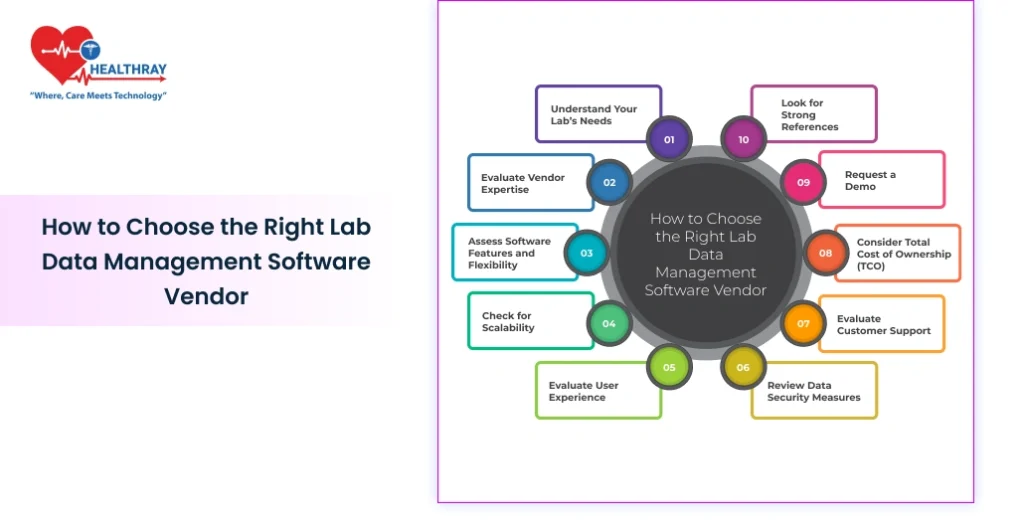
You have to make sure you pick the correct lab data management software vendor for your operational objectives to be met. With so many options available on the market, choosing correctly might be hard. Presented is a guideline that will help in making a smart decision.
Understand Your Lab’s Needs
Before researching vendors, consider your lab’s current pain points and your future goals. Ask yourself:
1. What specific issues are you trying to solve?
2. Which workflows need automation?
3. How much scalability will you need over the next 3-5 years?
Assess Vendor Expertise
Not all vendors have experience and expertise in the same type of lab. Make sure the vendor you are interested in has experience in your kind of labs, whether it be biotech, pharma, or clinical research.
Key Questions to Ask:
1. Do they have case studies or references in your field?
2. To what extent are they aware of GLP, FDA, or ISO compliance requirements?
Assessing Software Features and Flexibility
The required solution would provide all the core features but it needs to allow for the adaptation of those features to specific workflows. It should also be integrated seamlessly with your current systems.
Must-Have Features:
1.Sample tracking and inventory management
2. Automation of repetitive tasks
3. Integration with laboratory instrumentation and third-party platforms
Check for Scalability
A vendor solution should grow with your lab. Whether adding more instruments, expanding the volume of data, or managing multiple lab locations, the software should adapt without major disruptions.
Look for:
1. Modular features you can add as needed
2. Compatibility with cloud infrastructure for remote access
Evaluating User Experience
The best software in the world isn’t going to be of any use if it’s too complicated for your team to work with. You want a clean, intuitive interface and top-notch onboarding support.
Key Considerations:
1. Does the vendor provide training programs?
2. How easily can the software be learned by non-technical staff?
Review Data Security Measures
Data confidentiality is of prime importance in industries dealing with biotech and pharma. The vendor should be able to provide sufficient security protocols to guard sensitive information.
Security Features to Expect:
1. Data encryption at rest and in transit
2. Role-based access controls
3. Regular updates of the software with fixes of critical vulnerabilities
Review Customer Service
The support system from a vendor can make or break your experience. Efficient customer service means issues get resolved in the shortest time possible; hence, there is minimal system downtime.
Questions to Ask:
1. What is their average response time?
2. Is it available 24/7, or is it only during business hours?
Consider Total Cost of Ownership
Apart from upfront costs, consider the long-term expenses that include subscription fees, maintenance costs, and upgrade costs.
Request a Demo
Never commit to a purchase before you have been given a hands-on demonstration. This may give you first-hand insight into the software’s usability, the features available, and its performance.
What to Observe During the Demo:
1. Speed and responsiveness of the system
2.How it handles your lab’s particular workflows
3.Feedback from your team members who use it on a daily basis
Look for Strong References
Finally, ask for a list of references from existing clients. Sometimes it is enlightening to hear the experiences of other laboratories about a particular vendor concerning its reliability and effectiveness of the software.
Conclusion
The lab information management software is no longer a tool but an integral component for labs to remain competitive and productive in the fast-emerging biotech and pharma industries. It helps lab managers and decision-makers get back to innovation and results by sorting out the day-to-day pain points on data overload, compliance, and inefficient workflows. The right HMS brings ease in day-to-day operations since it acts like a strategic partner in driving growth, cost reduction, and ensuring quality. Be it maintaining large volumes of research data, performing clinical testing, or addressing regulatory compliance, a robust investment can make all the difference in the way your lab works.
